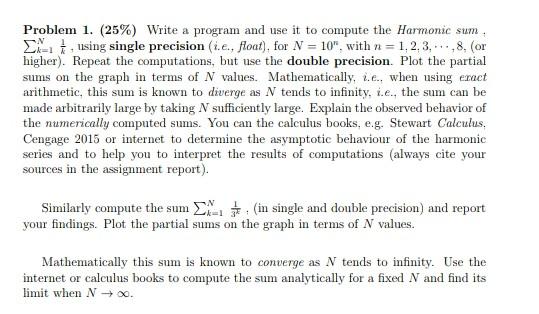Answered step by step
Verified Expert Solution
Question
1 Approved Answer
please provide analytical solution with detailed steps with explanation and justification asap (Programming not required) Problem 1. (25%) Write a program and use it to
please provide analytical solution with detailed steps with explanation and justification asap (Programming not required)

Problem 1. (25%) Write a program and use it to compute the Harmonic sum EX using single precision (i.e., float), for N = 10". with n=1,2,3,.,8. (or higher). Repeat the computations, but use the double precision. Plot the partial sums on the graph in terms of N values. Mathematically, i.e., when using eract arithmetic, this sum is known to diverge as N tends to infinity, i.e., the sum can be made arbitrarily large by taking N sufficiently large. Explain the observed behavior of the numerically computed sums. You can the calculus books, e.g. Stewart Calculus, Cengage 2015 or internet to determine the asymptotic behaviour of the harmonic series and to help you to interpret the results of computations always cite your sources in the assignment report). Similarly compute the sum Ex(in single and double precision) and report your findings. Plot the partial sums on the graph in terms of N values. Mathematically this sum is known to converge as N tends to infinity. Use the internet or calculus books to compute the sum analytically for a fixed N and find its limit when N
Step by Step Solution
There are 3 Steps involved in it
Step: 1

Get Instant Access to Expert-Tailored Solutions
See step-by-step solutions with expert insights and AI powered tools for academic success
Step: 2

Step: 3

Ace Your Homework with AI
Get the answers you need in no time with our AI-driven, step-by-step assistance
Get Started


